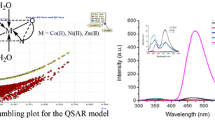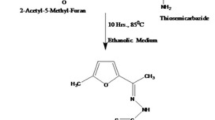Abstract
The tridentate Schiff base ligand was prepared via condensation of 4,6-diacetylresorcinol and 1,8-naphthalenediamine in 1:1 molar ratio using conventional method. Additionally, a new series of transition metal complexes of Cr(III), Mn(II), Fe(III), Co(II), Ni(II), Cu(II), Zn(II) and Cd(II) metal ions were prepared and fully characterized by elemental analysis, FT-IR, 1H NMR, UV–vis, conductivity and magnetic susceptibility measurements and theoretically through density function theory (DFT). Spectral studies suggested that, the Schiff base coordinated to the metal ions through the azomethine N, N-amine and phenolic oxygen atoms. From the elemental, magnetic susceptibility and spectroscopic data, the complexes were suggested to have octahedral geometry. The Schiff base and its metal complexes were screened for their in vitro antimicrobial activities and showed that Cd(II), Cu(II) and Cr(III) complexes have high activity against Escherichia coli, while Ni(II) and Cd(II) complexes have the highest activity against Bacillus Subtilis, Co(II) complex has the highest activity against Staphylococcus aureus and Cd(II) complex has the highest activity against Pseudomonas aeruginosa. In addition, the molecular docking study was performed to explore the possible ways for binding to crystal structure of Staphylococcus aureus nucleoside diphosphate kinase complexed with ADP (PDB ID: 3Q8U).













Similar content being viewed by others
References
M.B.A. Afonso, T.R. Cruz, Y.F. Silva et al., Ruthenium(II) complexes of Schiff base derived from cycloalkylamines as pre-catalysts for ROMP of norbornene and ATRP of methyl methacrylate. J. Organomet. Chem. 851, 225–234 (2017)
S. Malik, B. Jain, A.S. Mirza, A. Singh, Review study on metal complexes synthesized from therapeutically important Schiff. Pharm. Chem. J. 3, 119–124 (2016)
K. Brodowska, E. Łodyga-Chruścińska, Schiff bases—interesting range of applications in various fields of science. Chemik 68, 129–134 (2014)
M.Y. Nassar, T.Y. Mohamed, I.S. Ahmed, One-pot solvothermal synthesis of novel cobalt salicylaldimine-urea complexes: a new approach to Co3O4 nanoparticles. J. Mol. Struct. 1050, 81–87 (2013)
M.Y. Nassar, H.M. Aly, M.E. Moustafa, E.A. Abdelrahman, Synthesis, characterization and biological activity of new and their Cu (II) complexes: a new approach to CuO nanoparticles for photocatalytic degradation of methylene blue. J. Inorg. Organomet. Polym. Mater. 27, 1220–1233 (2017)
W.H. Mahmoud, N.F. Mahmoud, G.G. Mohamed, New nanobidentate Schiff base ligand of 2-aminophenol with 2-acetyl ferrocene with some lanthanide metal ions: synthesis, characterization and Hepatitis A, B, C and breast cancer docking studies. J. Coord. Chem. 70, 3552–3574 (2017)
M. Shebl, M.A. El-Ghamry, S.M.E. Khalil, M.A.A. Kishk, Mono- and binuclear copper(II) complexes of new hydrazone ligands derived from 4,6-diacetylresorcinol: synthesis, spectral studies and antimicrobial activity. Spectrochim. Acta Part A Mol. Biomol. Spectrosc. 126, 232–241 (2014)
K. Dhahagani, M.P. Kesavan, G. Gangatharan et al., Crystal structure, optical properties, DFT analysis of new morpholine based Schiff base ligands and their copper(II) complexes: DNA, protein docking analyses, antibacterial study and anticancer evaluation. Mater. Sci. Eng. C. 1(90), 119–130 (2018)
W.H. Mahmoud, R.G. Deghadi, G.G. Mohamed, Novel Schiff base ligand and its metal complexes with some transition elements. Synthesis, spectroscopic, thermal analysis, antimicrobial and in vitro anticancer activity. Appl. Organomet. Chem. 30, 221–230 (2016)
A.W. Bauer, W.M. Kirby, C. Sherris, M. Turck, Antibiotic susceptibility testing by a standardized single disk method. Am. J. Clin. Pathol. 45, 493–496 (1966)
L.D. Liebowitz, H.R. Ashbee, E.G. Evans, Y. Chong, N. Mallatova, M. Zaidi, D. Gibbs, Global Antifungal Surveillance Group, a two year global evaluation of the susceptibility of Candidaspecies to fluconazole by disk diffusion. Diagn. Microbiol. Infect. 40, 27–33 (2001)
J.C. Chang, P.R. Hsueh, J.J. Wu, S.W. Ho, W.C. Hsieh, K.T. Luh, Antimicrobial susceptibility of flavobacteria as determined by agar dilution and disk diffusion methods. Antimicrob. Agents Chemother. 41, 1301–1306 (1997)
Pa. Villanova, National Committee for Clinical Laboratory Standards. Methods for dilution antimicrobial susceptibility tests for bacteria that grow aerobically. Approved standard M7-A3. National Committee for Clinical Laboratory Standards (1993)
M.J. Matar, L. Ostrosky-Zeichner, V.L. Paetznick, J.R. Rodriguez, E. Chen, J.H. Rex, Correlation between E-test, disk diffusion, and microdilution methods for antifungal susceptibility testing of fluconazole and voriconazole. Antimicrob. Agents Chemother. 47, 1647–1651 (2003)
P. Skehan, R. Storeng, D. Scudiero, A. Monks, J. McMahon, D. Vistica, J.T. Warren, H. Bokesch, S. Kenney, M.R. Boyd, New colorimetric cytotoxicity assay for anti- cancer-drug screening. J. Natl. Cancer Inst. 82, 1107 (1990)
W.H. Mahmoud, G.G. Mohamed, O.Y. El-Sayed, Coordination compounds of some transition metal ions with new Schiff base ligand derived from dibenzoyl methane. Structural characterization, thermal behavior, molecular structure, antimicrobial, anticancer activity and molecular docking studies. Appl. Organomet. Chem. 32, e4051 (2017)
M.N. Ibrahim, S.A.I. Sharif, Synthesis, characterization and use of Schiff bases as fluorimetric analytical reagents (Part II). E-J. Chem. 8, 180–184 (2011)
L.H. Abdel-rahman, N.M. Ismail, M. Ismael, A.M. Abu-dief, E.A. Ahmed, Synthesis, characterization, DFT calculations and biological studies of Mn (II), Fe (II), Co (II) and Cd (II) complexes based on a tetradentate ONNO donor Schiff base ligand. J Mol Struct. 1134, 851–862 (2017)
M.R. Maurya, L. Rana, F. Avecilla, Phloroglucinol and resorcinol based mononuclear dioxidomolybdenum(VI) complexes: synthesis, structural characterization and catalytic epoxidation. Polyhedron 126, 60–71 (2017)
A.B. Deilami, M. Salehi, A. Arab, A. Amiri, Synthesis, crystal structure, electrochemical properties and DFT calculations of three new Zn (II), Ni (II) and Co (III) complexes based on. Inorg. Chim. Acta. 476, 93–100 (2018)
M.L. Smith, K.G. Paul, Infrared spectroscopic evidence of hydrogen bonding between carbon monoxide and protein in carbonylhorseradish peroxidase C. FEBS Lett. 163, 303–305 (1983)
M. Jafari-moghaddam, S.A. Beyramabadi, M. Khashi, A. Morsali, Three VO2+ complexes of the pyridoxal-derived Schiff bases: synthesis, experimental and theoretical characterizations, and catalytic activity in a cyclocondensation reaction. J. Mol. Struct. 1153, 149–156 (2017)
Y. Liu, J. Sheng, D. Yin et al., Ferrocenyl chalcone-based Schiff bases and their metal complexes: highly efficient, solvent-free synthesis, characterization, biological research. J. Organomet. Chem. 856, 27–33 (2018)
R. Katava, M. Rajic, G. Pavlovic, On the zinc ( II ) and mercury (II) compounds 6with Schiff-base N - ( p -anisoyl ) -2-oxo-1-naphthylideneamine Tautomerism of the ligand and polymerization of mercury compound via Hg…I contact. Polyhedron 123, 285–292 (2017)
W.H. Mahmoud, N.F. Mahmoud, G.G. Mohamed, Spectroscopic characterization and molecular docking studies of acetyl ferrocene-derived Schiff base ligand with phenanthroline and some transition metal ions. J. Therm. Anal. Calorim. 131, 2775–2793 (2017)
E. Yousif, A. Majeed, K. Al-Sammarrae, N. Salih, J. Salimon, B. Abdullah, Metal complexes of Schiff base: preparation, characterization and antibacterial activity. Arab. J. Chem. 10, 1639-S1644 (2017)
A.A.A. Emara, O.M.I. Adly, Synthesis and spectroscopic studies of new binuclear transition metal complexes of Schiff bases derived from 4,6-diacetylresorcinol. Transit Met. Chem. 32, 889–901 (2007)
J.H. Pandya, R.N. Jadeja, K.J. Ganatra, Spectral characterization and biological evaluation of Schiff bases and their mixed ligand metal complexes derived from 4,6-diacetylresorcinol. J. Saudi Chem. Soc. 18, 190–199 (2014)
E.S. Aazam, M.P. Coles, Simple generation of neutral bimetallic aluminium and zinc alkyls Schiff bases bridged by a central resorcinol moiety. Cent. Eur. J. Chem. 8, 1305–1310 (2010)
M. Shakir, M. Azam, M.F. Ullah, S.M. Hadi, Synthesis, spectroscopic and electrochemical studies of N, N-bis[(E)-2-thienylmethylidene]-1,8-naphthalenediamine and its Cu(II) complex: DNA cleavage and generation of superoxide anion. J. Photochem. Photobiol. B Biol. 104, 449–456 (2011)
P. Tyagi, M. Tyagi, S. Agrawal, S. Chandra, H. Ojha, M. Pathak, Synthesis, characterization of 1, 2, 4-triazole Schiff base derived 3d-metal complexes: induces cytotoxicity in HepG2, MCF-7 cell line, BSA binding fluorescence and DFT study. Spectrochim. Acta Part A Mol. Biomol. Spectrosc. 171, 246–257 (2017)
A.A.A. Abou-Hussein, W. Linert, Synthesis, spectroscopic and biological activities studies of acyclic and macrocyclic mono and binuclear metal complexes containing a hard-soft Schiff base. Spectrochim. Acta Part A Mol. Biomol. Spectrosc. 95, 596–609 (2012)
W.H. Mahmoud, R.G. Deghadi, G.G. Mohamed, Preparation, geometric structure, molecular docking thermal and spectroscopic characterization of novel Schiff base ligand and its metal chelates: screening their anticancer and antimicrobial activities. J. Therm. Anal. Calorim. 127, 2149–2171 (2017)
C.E. Housecroft, A.G. Sharpe, Inorganic Chemistry (Third, Pearson Education, 2008)
W.H. Mahmoud, F.N. Sayed, G.G. Mohamed, Synthesis, characterization and in vitro antimicrobial and anti-breast cancer activity studies of metal complexes of novel pentadentate azo dye ligand. Appl. Organomet. Chem. 30, 959–973 (2016)
A. Thakar, K. Joshi, K. Pandya, A. Pancholi, Coordination modes of a Schiff Base derived from substituted 2-aminothiazole with chromium(III), manganese(II), iron(II), cobalt(II), nickel(II) and copper(II) metal ions : synthesis spectroscopic and antimicrobial studies. J. Chem. 8, 1750–1764 (2011)
S.K. Tadavi, A.A. Yadav, R.S. Bendre, Synthesis and characterization of a novel schiff base of 1,2-diaminopropane with substituted salicyaldehyde and its transition metal complexes: Single crystal structures and biological activities. J. Mol. Struct. 1152, 223–231 (2017)
B. Assay, S. Base, B. Iftikhar et al., Synthesis, characterization and biological assay of salicylaldehyde Schiff Base Cu(II) complexes and their precursors. J Mol Struct. 1155, 337–348 (2017)
W.H. Mahmoud, M.M. Omar, Y.M. Ahmed, G.G. Mohamed, Transition metal complexes of Schiff base ligand based on 4,6-diacetyl resorcinol. Appl. Organomet. Chem. 34, 1–20 (2020)
W.H. Mahmoud, R.G. Deghadi, G.G. Mohamed, Metal complexes of novel Schiff base derived from iron sandwiched organometallic and 4-nitro-1,2-phenylenediamine: synthesis, characterization, DFT studies, antimicrobial activities and molecular docking. Appl. Organomet. Chem. 32, e4289 (2018)
N.S. Al-Radadi, E.M. Zayed, G.G. Mohamed, H.A. Abd El Salam, Synthesis, spectroscopic characterization, molecular docking, and evaluation of antibacterial potential of transition metal complexes obtained using triazole chelating ligand. J. Chem. 1548641, 1–12 (2020)
R.G. Deghadi, W.H. Mahmoud, G.G. Mohamed, Metal complexes of tetradentate azo-dye ligand derived from 4,4′-oxydianiline: preparation, structural investigation, biological evaluation and MOE studies. Appl. Organomet. Chem. 34, 1–20 (2020)
Author information
Authors and Affiliations
Corresponding author
Additional information
Publisher's Note
Springer Nature remains neutral with regard to jurisdictional claims in published maps and institutional affiliations.
Rights and permissions
About this article
Cite this article
Ahmed, Y.M., Mahmoud, W.H., Omar, M.M. et al. Synthesis, Characterization and Biological Activity of Transition Metals Schiff Base Complexes Derived from 4,6-Diacetylresorcinol and 1,8-Naphthalenediamine. J Inorg Organomet Polym 31, 2339–2359 (2021). https://doi.org/10.1007/s10904-020-01867-1
Received:
Accepted:
Published:
Issue Date:
DOI: https://doi.org/10.1007/s10904-020-01867-1




